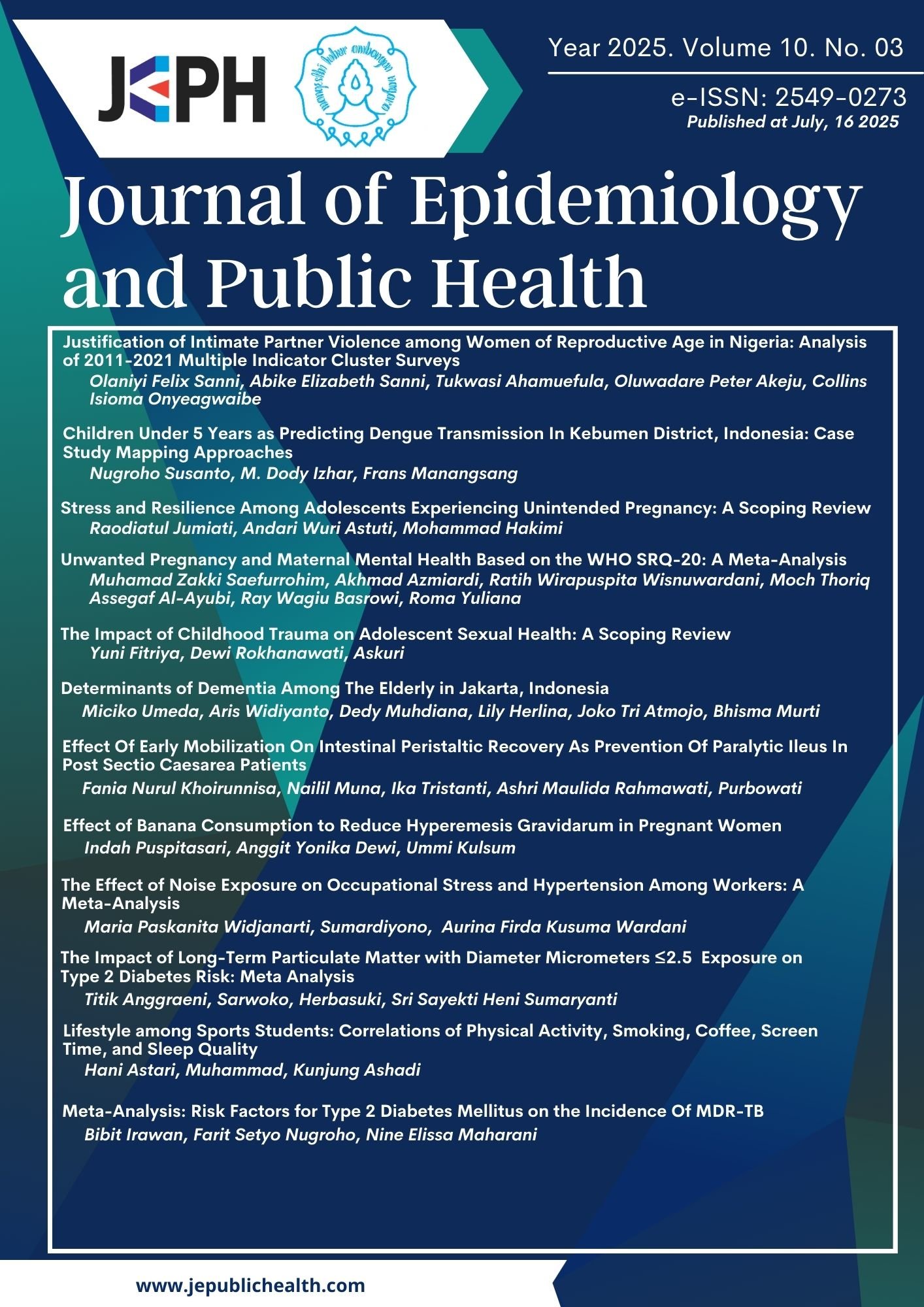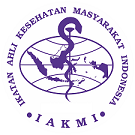Lifestyle among Sports Students: Correlations of Physical Activity, Smoking, Coffee, Screen Time, and Sleep Quality
DOI:
https://doi.org/10.26911/jepublichealth.2025.10.03.11Abstract
Background: A healthy lifestyle is an important factor in achieving a high quality of life.. However, research exploring the impact of smoking habits on physical activity levels among students remains limited. This study aims to determine the correlation between smoking habits and physical activity among sports students.
Subjects and Methods: This quantitative research study employed a simple random sampling technique to select 105 students from the Sports Coaching Education program. The students completed self-administered questionnaires to assess their daily smoking habits and weekly physical activity levels. In this study, smoking habits are the dependent variable, while physical activity is the independent variable. The data were analyzed using the Spearman Correlation Test to determine the strength and direction of the relationship between the two variables.
Results: The results indicated that 26% of the student population were active smokers, and 27% had insufficient levels of physical activity. Although no statistically significant correlation (p= 0.627) was found between smoking habits and physical activity among the students, a negative correlation trend (r= -0.048) was observed. This suggests that higher smoking levels may be associated with decreased physical activity levels.
Conclusion: These results demonstrate that increased smoking may reduce physical activity participation. Therefore, promoting healthy lifestyles among students is crucial for enhancing their life quality.
Keywords:
Lifestyle, Exercise, physical activity, smoking, coffee, screen time, sleep qualityHow to Cite
References
Aceijas C, Waldhäusl S, Lambert N, Cassar S, Bello CR. (2016). Determinants of health related lifestyles among university students. SAGE Publications Sage UK: London, England. 137(4): 227–236. doi: 10.1177/175791391666687.
Adriansen RC, Childers A, Yoder T, Abraham S (2017). Sleeping habits and perception of its health effects among college students. Int J Stud Nurs. 2(2): 28. doi: 10.20849/IJSN.V2I2.206.
Ahmed N, Sadat M, Cukor D (2017). Sleep knowledge and behaviors in medical students: Results of a single center survey. Acad Psychiatry. 41(5): 674–678. doi: 10.1007/S40596-016-0655-3/TABLES/2
Akl EA, Ward KD, Bteddini D, Khaliel R, Alexander AC, Lotfi T, Alaouie H, et al. (2015). The allure of the waterpipe: A narrative review of factors affecting the epidemic rise in waterpipe smoking among young persons globally. Tobacco Control. 24(Suppl 1): i13–i21. doi: 10.1-136/TOBACCOCONTROL-2014-051-906.
Alfawaz HA, Khan N, Yakout SM, Khattak MNK, Alsaikhan AA, Almousa AA, Alsuwailem TA, et al. (2020). Prevalence, Predictors, and Awareness of Coffee Consumption and Its Trend among Saudi Female Students. Int J Environ Res Public Health. 17(19): 7020. doi: 10.3390/IJERPH17197020
Alfurqon W (2021). Pengaruh merokok terhadap kualitas tidur pada mahasiswa. Thesis. Universitas Muhammadiyah Surakarta.
Almutairi KM, Alonazi WB, Vinluan JM, Almigbal TH, Batais MA, Alodhayani AA, Alsadhan N, et al. (2018). Health-promoting lifestyle of university students in Saudi Arabia: A cross-sectional assessment. BMC Public Health. 18(1): 1–10. doi: 10.1186/S12889-018-5999-Z/TABLES/3.
Farhud DD (2015). Impact of lifestyle on health. Iranian J Public Health. 44(11): 1442. doi: 10.5040/9798400690945.ch-008.
McLean-Meyinsse PE, Taylor SS, Gager JV (2015). Self reported consumption of fast food meals by university students. J Food Distrib Res. 46(1). doi: 10.22004/AG.ECON.198997.
Mohammadbeigi A, Asgarian A, Moshir E, Heidari H, Afrashteh S, Khazaei S, Ansari H (2018). Fast food consumption and overweight/obesity prevalence in students and its association with general and abdominal obesity. J Prev Med Hyg. 59(3): E236. doi: 10.15167/2421-4248/JPMH2018.59.3.830.
Nakshine VS, Thute P, Khatib MN, Sarkar B (2022). Increased screen time as a cause of declining physical, psychological health, and sleep patterns: A literary review. Cureus. doi:10.7759/cureus.30051
Nasser AMA, Geng Y, Al-Wesabi SA (2020). The prevalence of smoking (cigarette and waterpipe) among university students in some Arab countries: A systematic review. Asian Pac J Cancer Prev. 21(3): 583–591. doi: 10.31557/APJCP.2020.21.3.583.
O’callaghan F, Muurlink O, Reid N (2018). Effects of caffeine on sleep quality and daytime functioning. Risk Manag Healthc Policy. 11: 263. doi: 10.2147/RMHP.S156404.
Pengpid S, Peltzer K, Kassean HK, Tsala Tsala JP, Sychareun V, Müller-Riemenschneider F (2015). Physical inactivity and associated factors among university students in 23 low-, middle-, and high-income countries. Int J Public Health. 60(5): 539–549. doi: 10.1007/S00038-015-0680-0.
Rababah JA, Al-Hammouri MM (2023). Health literacy and smoking habits among a sample of Jordanian university students. J Community Health. 48(1): 30–37. doi: 10.1007/S10900-022-01398
Ramón-Arbués E, Gea-Caballero V, Granada-López JM, Juárez-Vela R, Pellicer-García B, Antón-Solanas I (2020). The prevalence of depression, anxiety, and stress and their associated factors in college students. Int J Environ Res Public Health. 17(19): 7001. doi: 10.3390/IJERPH17197001
Ramón-Arbués E, Granada-López JM, Martínez-Abadía B, Echániz-Serrano E, Antón-Solanas I, Jerue BA (2022). The association between diet and sleep quality among Spanish university students. Nutrients. 14(16): 3291. doi: 10.3390/NU14163291.
Sears CG, Hart JL, Walker KL, Robertson RM (2017). Generally recognized as safe: Uncertainty surrounding e-cigarette flavoring safety. Int J Environ Res Public Health. 14: 1274. doi: 10.3390/IJERPH14101274.
Torquati L, Peeters G, Brown WJ, Skinner TL (2018). A daily cup of tea or coffee may keep you moving: Association between tea and coffee consumption and physical activity. Int J Environ Res Public Health. 15: 1812. doi: 10.3390/IJERPH15091812.
Wu X, Tao S, Zhang Y, Zhang S, Tao F (2015). Low physical activity and high screen time can increase the risks of mental health problems and poor sleep quality among Chinese college students. PLoS One. 10(3): e0119607. doi: 10.1371/JOURNAL.PONE.0119607.
Xu H, Wen LM, Rissel C (2015). Associations of parental influences with physical activity and screen time among young children: A systematic review. J Obes. 2015:546925. doi: 10.1155/2015/546925.
Yahia N, Wang D, Rapley M, Dey R (2015). Assessment of weight status, dietary habits and beliefs, physical activity, and nutritional knowledge among university students. J Appl Health Behav. 136(4):231–244. doi: 10.1177/1757913915609945.



1.jpg)








